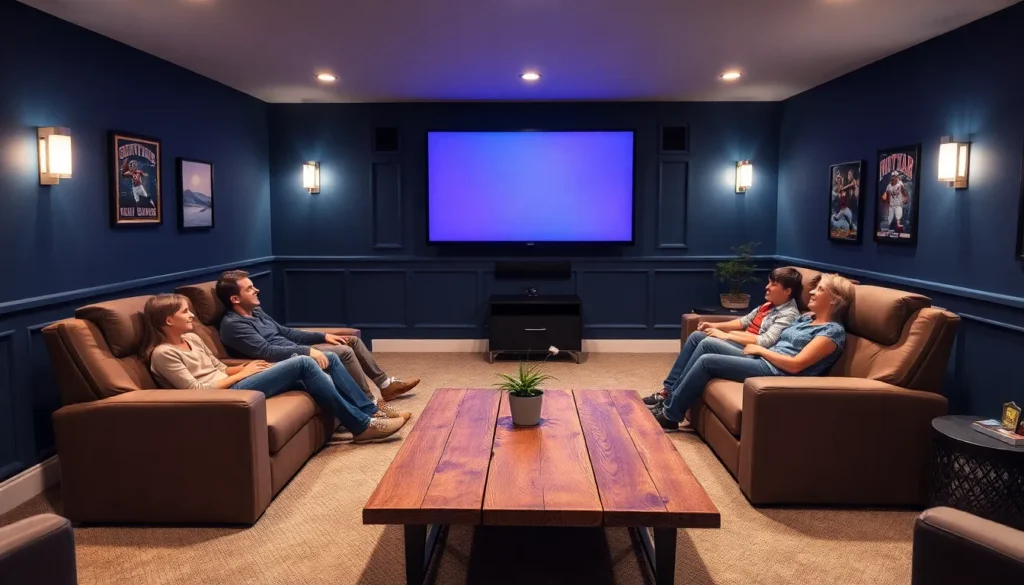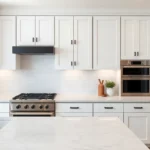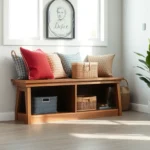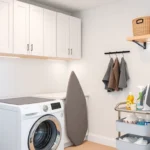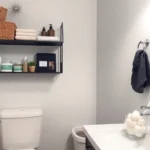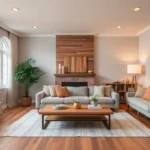Transforming your basement into the ultimate TV room can turn that underutilized space into your home’s most coveted retreat. We’ve all dreamed of having a dedicated entertainment sanctuary where we can binge-watch our favorite shows, host movie nights, or catch the big game without interruptions.
Your basement offers unique advantages that other rooms simply can’t match – natural sound insulation, flexible layout options, and the perfect opportunity to create a true escape from daily distractions. Whether you’re working with a finished basement or starting from scratch, we’ll show you how to maximize every square foot for comfort and functionality.
From cozy family-friendly setups to sophisticated home theater experiences, the possibilities for your basement TV room are endless. We’ll explore creative design answers that address common basement challenges while helping you create a space that perfectly matches your entertainment style and budget.
Transform Your Basement Into the Ultimate Entertainment Space
Converting your basement into an entertainment hub requires strategic planning to maximize both comfort and functionality. We’ll guide you through the essential elements that make basement TV rooms exceptional gathering spaces.
Planning Your Layout for Maximum Comfort
Start by measuring your basement dimensions to determine the optimal furniture arrangement. We recommend creating distinct zones within your space – a primary viewing area with your main seating, a secondary lounge zone for casual conversation, and storage areas for games and media equipment.
Position your main seating 8 to 12 feet from your TV screen for the most comfortable viewing experience. This distance prevents eye strain while ensuring everyone can see details clearly without feeling overwhelmed by the display size.
Consider traffic flow patterns when arranging furniture to avoid blocking pathways to stairs, storage areas, or utility access points. We suggest floating furniture pieces away from walls to create more intimate conversation areas and improve sound acoustics.
Add flexible seating options like ottomans, floor cushions, or modular sectionals that can be reconfigured for different entertainment scenarios. These pieces accommodate varying group sizes while maintaining the room’s primary TV viewing focus.
Choosing the Right Size TV for Your Space
Calculate your ideal TV size using the 1.5 to 2.5 times rule – multiply your viewing distance in inches by 0.6 to 0.84 to determine the recommended screen diagonal. For example, if you’re sitting 10 feet away, a 65 to 75 inch TV provides optimal viewing.
| Viewing Distance | Recommended TV Size |
|---|---|
| 6-8 feet | 43-55 inches |
| 8-10 feet | 55-65 inches |
| 10-12 feet | 65-75 inches |
| 12+ feet | 75+ inches |
Consider your basement’s ceiling height when selecting screen size to maintain proper proportions. Low ceilings under 8 feet work best with TVs under 65 inches, while standard height basements can accommodate larger displays without overwhelming the space.
Factor in your basement’s width to ensure the TV doesn’t dominate the room visually. We recommend keeping your TV size to no more than one third of your wall’s width for balanced aesthetics.
Mount your TV at eye level when seated to reduce neck strain during extended viewing sessions. This typically places the center of your screen 42 to 48 inches from the floor in most basement TV room setups.
Optimizing Lighting for Movie Watching
Install dimmer switches on all overhead lighting to create the perfect ambiance for different entertainment activities. Bright lighting works well for gaming or sports viewing, while dimmed lighting enhances movie watching experiences.
Add bias lighting behind your TV to reduce eye strain and improve perceived contrast. We recommend LED strips that produce neutral white light at about 10% of your TV’s brightness level.
Position accent lighting away from your screen to prevent glare and reflections that interfere with viewing. Table lamps, floor lamps, and wall sconces should illuminate seating areas without casting light directly onto your display.
Consider blackout window treatments if your basement has windows that allow natural light. Heavy curtains or cellular shades block outside light during daytime movie sessions and provide better control over your room’s lighting environment.
Use pathway lighting for safety without disrupting your entertainment experience. LED strip lights under stairs, along baseboards, or around doorways provide necessary illumination for movement while maintaining your room’s cinema atmosphere.
Create a Cozy Home Theater Experience

Transforming your basement into a cinematic sanctuary requires careful attention to audio, seating, and lighting elements. We’ll guide you through the essential components that elevate your space from a simple TV room to an immersive entertainment destination.
Installing Surround Sound Systems
In-wall speakers represent the optimal choice for basement theaters, particularly when dealing with low ceilings where space conservation becomes critical. These speakers eliminate floor clutter while delivering exceptional audio quality throughout your viewing area.
Compact audio systems work perfectly for smaller basement spaces where traditional surround sound setups might overwhelm the room. Soundbars offer an excellent alternative that provides enhanced audio without requiring extensive installation.
Soundproofing materials should be incorporated during the drywall installation phase to minimize external noise interference. This approach ensures your audio experience remains crystal clear while preventing sound from traveling to other areas of your home.
Selecting Theater Style Seating Options
Theater style recliners can instantly convert your basement living area into a professional home theater setup. These specialized chairs provide the comfort and functionality needed for extended viewing sessions.
Tiered seating arrangements optimize both space utilization and viewing angles, especially important in basements with lower ceiling heights. Platform seating creates distinct viewing levels that accommodate multiple viewers without blocking sightlines.
Low profile furniture maintains the spacious feel that’s essential in basement environments. Selecting seating with reduced height profiles prevents the space from feeling cramped while ensuring comfortable viewing positions.
Adding Blackout Curtains or Window Treatments
Blackout curtains enhance the viewing experience significantly when basement windows are present, though many basement theaters benefit from complete darkness regardless of natural light sources. These treatments create the authentic theater atmosphere that makes movie watching more immersive.
Light control systems ensure your room remains optimally dark during screenings by using specialized blackout materials on any openings. Proper light management transforms your basement into a professional grade viewing environment that rivals commercial theaters.
Design a Multi-Functional Family Room
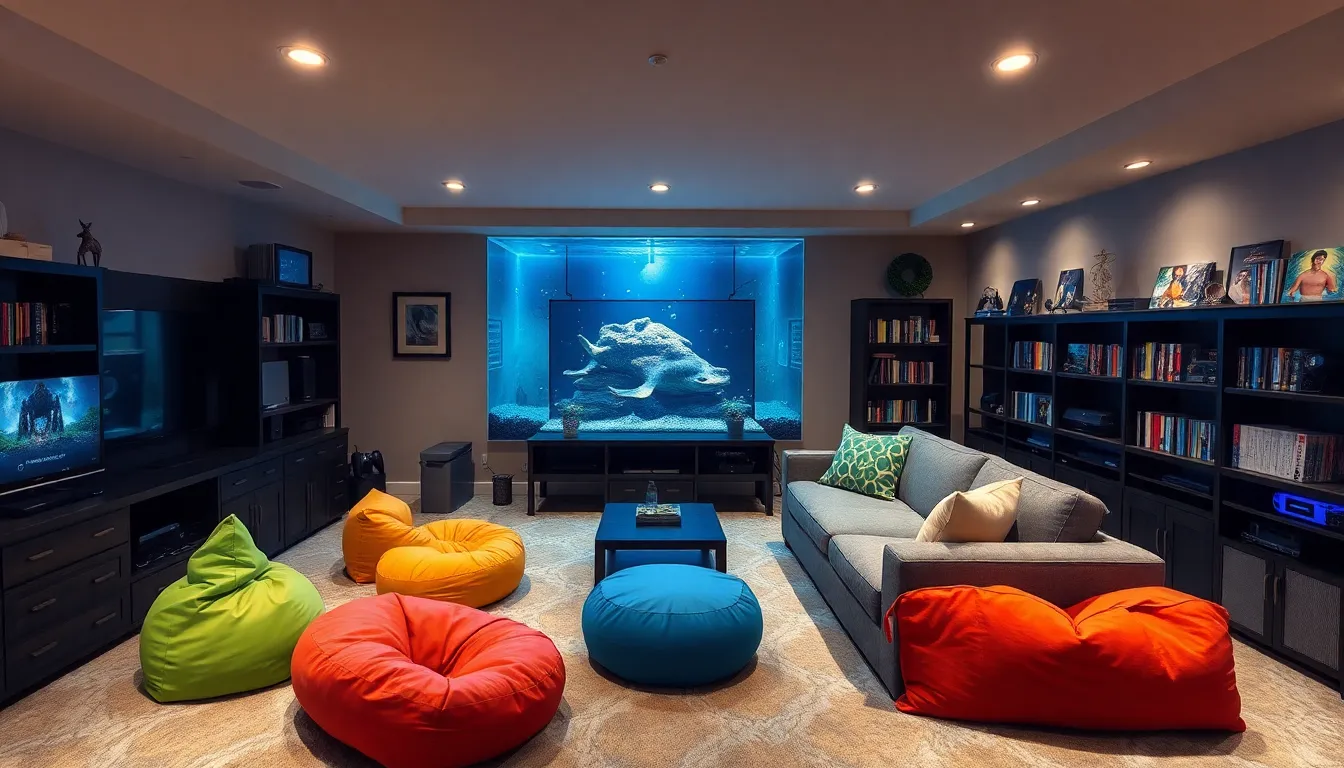
A well-designed basement family room serves multiple entertainment purposes beyond just watching TV. We can create spaces that accommodate gaming, media storage, and various seating arrangements to maximize functionality.
Incorporating Gaming Consoles and Equipment
Gaming stations transform your basement into an interactive entertainment hub that appeals to all family members. We recommend dedicating a exact corner or wall section for your gaming setup, complete with console storage and easy access to controllers and accessories.
Surround sound systems elevate both gaming and movie experiences significantly. Install speakers strategically around the room to create immersive audio that makes action sequences feel more realistic. Consider wireless speaker options to reduce cable clutter while maintaining high-quality sound distribution throughout the space.
Cable management becomes crucial when incorporating multiple gaming consoles and entertainment devices. Use cord organizers and cable trays to keep wires hidden and prevent tripping hazards. Mount power strips behind furniture or inside cabinets to maintain a clean aesthetic while providing adequate power for all your equipment.
Ventilation planning ensures your gaming equipment stays cool during extended use sessions. Position consoles away from heat sources and allow proper airflow around each device. Consider adding a small fan or ventilation system if your basement tends to retain heat.
Adding Storage Answers for Media and Accessories
Media storage answers keep your entertainment area organized while displaying your collection attractively. We suggest installing floating shelves along walls to house DVDs, gaming discs, and console accessories without taking up valuable floor space.
Built-in cabinets offer concealed storage for items you don’t want on display. Hide gaming controllers, cables, and spare equipment behind cabinet doors while keeping frequently used items within easy reach. Choose cabinets with adjustable shelves to accommodate different sized media and accessories.
Display cases add personality while showcasing collectibles and gaming memorabilia. Install glass-front cases to protect valuable items from dust while creating visual interest. Consider incorporating LED strip lighting inside cases to highlight your favorite pieces and create ambient lighting for the room.
Aquarium installations serve as unique focal points that double as room dividers. Position a well-maintained aquarium between seating areas to create distinct zones while adding a calming visual element. The gentle sound of water circulation can also provide pleasant background noise during quiet activities.
Creating Flexible Seating Arrangements
Flexible seating accommodates different group sizes and entertainment activities throughout the week. We recommend combining various seating types to create a ever-changing layout that adapts to your family’s changing needs.
Modular furniture pieces allow easy reconfiguration for different occasions. Choose sectional sofas that can be separated and rearranged, along with lightweight chairs that move easily around the room. This flexibility lets you optimize seating for movie nights, gaming tournaments, or casual conversations.
Comfortable recliners provide premium seating for extended viewing sessions. Position recliners at optimal viewing angles and distances from your main screen. Consider models with built-in cup holders and storage compartments to enhance the viewing experience without requiring additional side tables.
Bean bags and floor cushions offer casual seating options that appeal to younger family members. These lightweight alternatives can be easily stored when not needed and pulled out for large gatherings. Choose waterproof or easy-to-clean materials that withstand frequent use and potential spills.
Traffic flow planning ensures easy movement between seating areas and entertainment zones. Leave clear pathways between furniture groupings and maintain at least 3 feet of walking space around major seating pieces. This layout prevents crowding and allows family members to move freely during activities.
Tackle Moisture and Climate Control Issues

Moisture control forms the foundation of any successful basement TV room conversion. We’ll address the most critical climate challenges that can impact your entertainment space’s longevity and comfort.
Installing Proper Ventilation Systems
Exhaust fans create essential airflow patterns that prevent moisture accumulation in your basement entertainment area. We recommend installing bathroom-style exhaust fans rated at 50-80 CFM for spaces up to 300 square feet, ensuring adequate air circulation during movie nights and gaming sessions.
HVAC integration connects your basement TV room to your home’s existing heating and cooling system. Professional contractors can extend ductwork to maintain consistent temperatures year-round, typically costing $1,500-$3,000 for proper installation.
Fresh air intake vents balance the air pressure when exhaust systems remove stale air. We suggest positioning intake vents near the ceiling on opposite walls from exhaust fans to create cross-ventilation that keeps your entertainment space comfortable.
Mechanical ventilation systems like ERVs (Energy Recovery Ventilators) provide continuous fresh air exchange while maintaining energy efficiency. These systems cost $2,000-$4,000 installed but offer superior moisture control for serious home theater enthusiasts.
Using Dehumidifiers and Air Purifiers
Basement dehumidifiers maintain optimal humidity levels between 30-50% to protect your electronics and furniture. We recommend whole-house dehumidifiers with 70-90 pint capacity for most basement TV rooms, which effectively prevent condensation on windows and equipment.
Portable dehumidifiers offer flexible moisture control for smaller entertainment areas or targeted problem zones. Units with 30-50 pint capacity work well for rooms up to 2,000 square feet and include features like automatic drainage and humidity sensors.
Air purifiers remove airborne particles and allergens that can affect your viewing comfort. HEPA filter systems eliminate 99.97% of particles larger than 0.3 microns, creating cleaner air for extended movie marathons or gaming sessions.
Smart humidity monitoring systems track moisture levels and automatically adjust dehumidifier settings. Wi-Fi enabled devices let you monitor conditions remotely and receive alerts when humidity levels exceed recommended ranges.
Selecting Moisture-Resistant Materials
Waterproof paint creates a protective barrier on basement walls that prevents moisture penetration. We recommend using epoxy-based paints or moisture-resistant primers followed by semi-gloss finishes that withstand higher humidity levels common in below-grade spaces.
Vinyl and tile flooring offer superior moisture resistance compared to traditional carpeting or hardwood. Luxury vinyl planks (LVP) provide the appearance of wood while maintaining waterproof properties, making them ideal for basement entertainment areas.
Water-resistant furniture prevents damage from occasional moisture exposure and humidity fluctuations. Synthetic materials like polyester upholstery and metal or engineered wood frames resist warping and mold growth better than natural materials.
Moisture barriers underneath flooring create an additional layer of protection against concrete slab moisture. Plastic sheeting or specialized vapor barriers prevent ground moisture from reaching your flooring materials and causing damage to your entertainment setup.
Choose the Perfect Flooring for Your TV Room
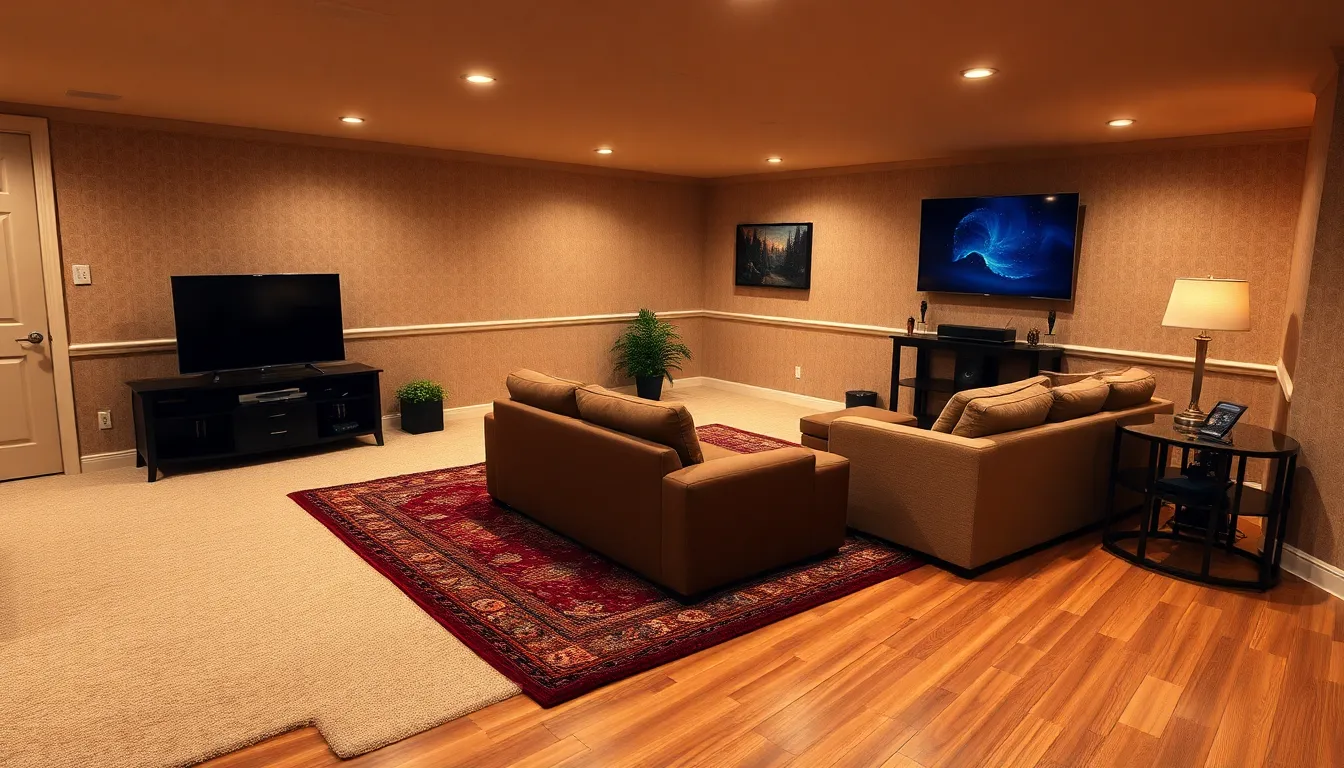
Flooring decisions significantly impact both the comfort and functionality of your basement TV room. We’ll explore the most effective options that balance durability, acoustics, and style for your entertainment space.
Comparing Carpet vs. Laminate Options
Carpet delivers exceptional warmth and acoustical benefits that enhance your viewing experience. We recommend choosing carpet for its natural sound absorption properties, which reduce echo and create better audio quality for movies and gaming. Carpet also provides comfort underfoot during long entertainment sessions and helps maintain consistent temperatures in cooler basement environments.
Laminate flooring offers superior durability and moisture resistance that makes it highly practical for basement installations. We find laminate particularly valuable because it withstands humidity fluctuations better than traditional hardwood while maintaining an attractive appearance. Laminate’s easy maintenance and stain resistance make it ideal for family rooms where spills and heavy foot traffic are common concerns.
Moisture considerations should guide your final flooring choice between these two options. We suggest laminate for basements with previous moisture issues or high humidity levels, while carpet works best in properly waterproofed spaces with excellent climate control systems already in place.
Installing Radiant Floor Heating
Radiant floor heating transforms cold basement floors into comfortable surfaces year round. We recommend installing electric radiant systems beneath tile or laminate flooring to provide consistent warmth without relying solely on your home’s HVAC system. These systems operate efficiently and create comfortable temperatures from the ground up.
Installation timing matters significantly when planning radiant heating for your TV room project. We advise incorporating radiant heating during initial flooring installation rather than retrofitting later, as this approach reduces costs and ensures proper system integration. Professional installation ensures optimal heating zones that match your seating arrangements and high traffic areas.
Energy efficiency benefits make radiant floor heating an excellent long term investment for basement entertainment spaces. We’ve observed that radiant systems often reduce overall heating costs while providing more consistent comfort than traditional forced air systems in below grade rooms.
Adding Area Rugs for Comfort and Style
Area rugs provide immediate warmth and style enhancement over any hard flooring surface in your TV room. We recommend placing large rugs beneath seating areas to create defined zones while adding acoustic benefits that improve your entertainment experience. Strategic rug placement also protects flooring from furniture scratches and wear patterns.
Size selection plays a crucial role in achieving professional looking rug arrangements throughout your space. We suggest choosing rugs large enough to extend at least 18 inches beyond your furniture edges, creating cohesive groupings that anchor your seating areas effectively. Multiple smaller rugs can define different activity zones within larger basement spaces.
Material choices should prioritize durability and moisture resistance for basement applications. We prefer synthetic fiber rugs or wool blends that resist mold and mildew while maintaining their appearance through regular use. Easy cleaning options become particularly important in high traffic entertainment areas where food and beverage spills occur frequently.
Incorporate Smart Storage Solutions
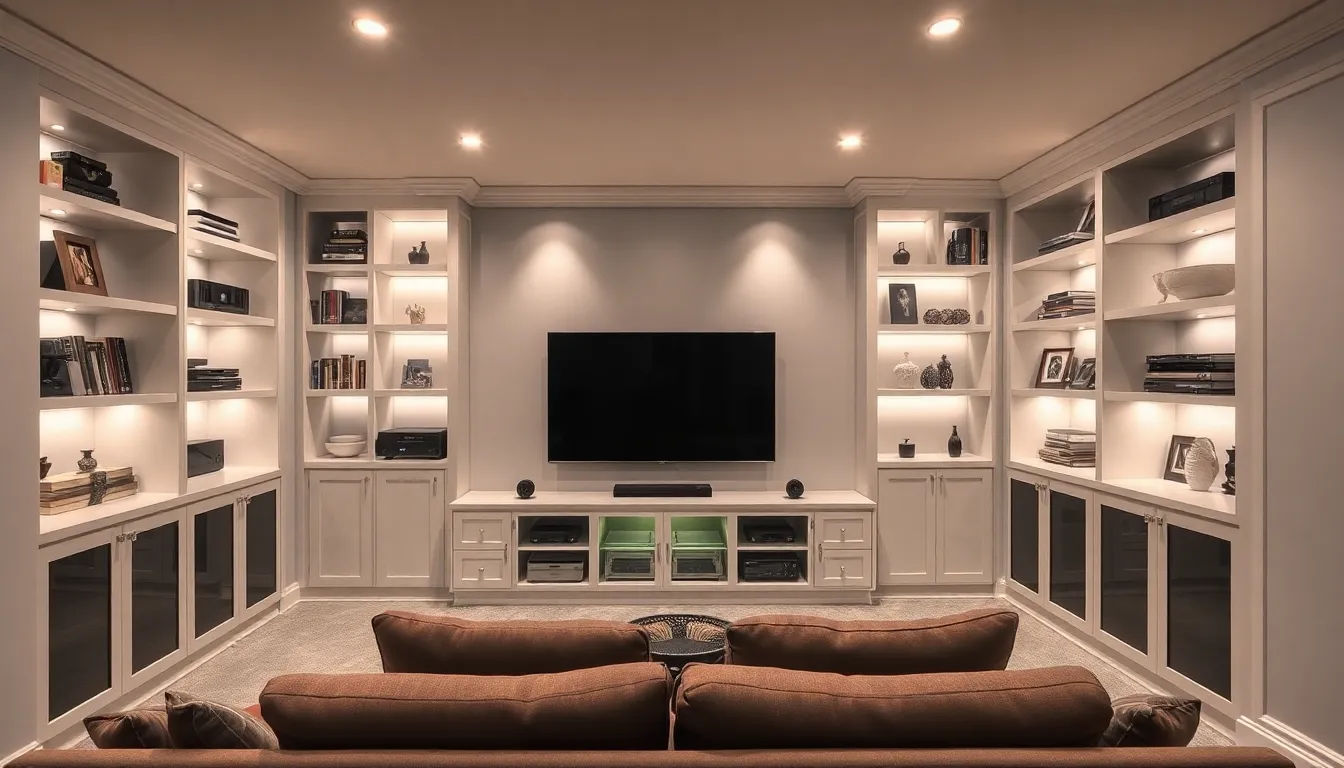
Smart storage transforms cluttered basement TV rooms into organized entertainment havens that maximize both function and style. We’ll explore three key approaches that help you create seamless storage while maintaining the room’s aesthetic appeal.
Building Custom Entertainment Centers
Custom entertainment centers serve as the focal point of your basement TV room while providing dedicated space for all your media components. We recommend designing a custom TV wall with built-in speakers and shelves specifically sized for your gaming consoles, streaming devices, and sound equipment.
Integrated lighting systems enhance the ambiance during movie nights while eliminating the need for additional floor or table lamps. Built-in compartments keep media devices organized and easily accessible, with cable management systems that hide unsightly wires behind the wall structure.
Customized dimensions ensure your entertainment center fits perfectly within your basement’s unique layout, whether you’re working around support beams, ductwork, or irregular ceiling heights. Consider incorporating adjustable shelving that adapts as your technology needs change over time.
Adding Built-In Shelving Units
Built-in shelving units maximize vertical space in your basement TV room while creating dedicated areas for books, collectibles, and decorative items. We suggest installing floor-to-ceiling shelves that use every inch of available wall space without overwhelming the room’s proportions.
Display opportunities emerge when you incorporate shelving units that showcase items matching your room’s theme, creating visual cohesion throughout the space. Strategic placement around your seating area keeps frequently used items within arm’s reach while maintaining the room’s clean lines.
Moisture-resistant materials prove essential for basement shelving, with sealed wood or composite materials that withstand humidity fluctuations better than traditional particleboard options. Proper ventilation around built-in units prevents moisture buildup that could damage stored items or the shelving structure itself.
Creating Hidden Storage Compartments
Hidden storage compartments use often-overlooked spaces to store seasonal items, board games, and extra blankets without cluttering your entertainment area. We recommend incorporating storage behind false walls, under staircases, or beneath custom seating areas where family members won’t accidentally discover your hiding spots.
Under-seating storage proves particularly valuable in basement TV rooms, where ottoman-style seating or built-in benches conceal gaming accessories, extra remotes, and throw pillows. Hydraulic hinges ensure smooth operation while preventing accidental slamming that could disturb others watching television.
Wall cavities between studs offer surprising storage potential for flat items like extra DVDs, important documents, or rarely used electronics. Professional installation ensures these compartments remain waterproof and easily accessible when needed, with magnetic or push-to-open mechanisms that maintain your room’s seamless appearance.
Select the Right Color Scheme and Decor
Color choices and decorative elements form the foundation of any successful basement TV room transformation. These design decisions directly impact both the functionality and atmosphere of your entertainment space.
Using Dark Colors to Enhance Screen Viewing
Dark colors create the optimal viewing environment by reducing glare and improving screen visibility. Navy blue and deep gray serve as excellent primary colors for basement TV rooms because they absorb ambient light rather than reflecting it back toward your screen.
Installing a dark accent wall behind your TV establishes a natural focal point while improving the cinematic experience. This backdrop technique minimizes eye strain during extended viewing sessions and creates better contrast for improved picture quality.
Dark-colored flooring options like charcoal laminate or espresso-stained wood complement the overall aesthetic while maintaining the light-absorbing benefits. These surfaces help create that immersive theater atmosphere we all crave in our home entertainment spaces.
Furniture selections in deep tones continue this theme throughout the room. Consider rich chocolate leather recliners or charcoal fabric sectionals that blend seamlessly with your dark color palette while providing the comfort needed for movie marathons.
Adding Accent Walls and Textures
Accent walls introduce visual depth and architectural interest to otherwise plain basement spaces. Stone veneer panels create stunning texture variations that catch light beautifully without causing screen glare issues.
Textured wall coverings like grasscloth or fabric panels add warmth and sophistication while serving practical acoustic purposes. These materials help absorb sound reflections that could interfere with your audio system’s performance.
Rugs become essential texture elements that define seating areas and add comfort underfoot. Large area rugs in plush materials create cozy conversation zones while protecting your flooring investment from heavy furniture placement.
Throw pillows and soft furnishings introduce additional texture layers without overwhelming the space. Mix different fabric weights like velvet cushions with linen throws to create visual and tactile interest throughout your seating arrangements.
Incorporating Personal Style Elements
Personal touches transform generic basement spaces into uniquely yours entertainment havens. Family photos displayed in gallery walls create conversation starters while showcasing your most treasured memories.
Sports team memorabilia adds personality and reflects your passions through framed jerseys, signed photographs, or trophy displays. These elements make guests feel welcome while expressing your individual interests and loyalties.
Custom wall art pieces customized to your entertainment preferences create focal points beyond the television screen. Movie posters from favorite films or vintage concert photographs establish the room’s entertainment theme while showcasing your cultural tastes.
Unique decorative pieces like vintage movie cameras or antique radios serve as conversation pieces that bridge entertainment history with modern technology. These collectibles add character while reinforcing the room’s primary purpose as your dedicated entertainment retreat.
Address Electrical and Technical Requirements
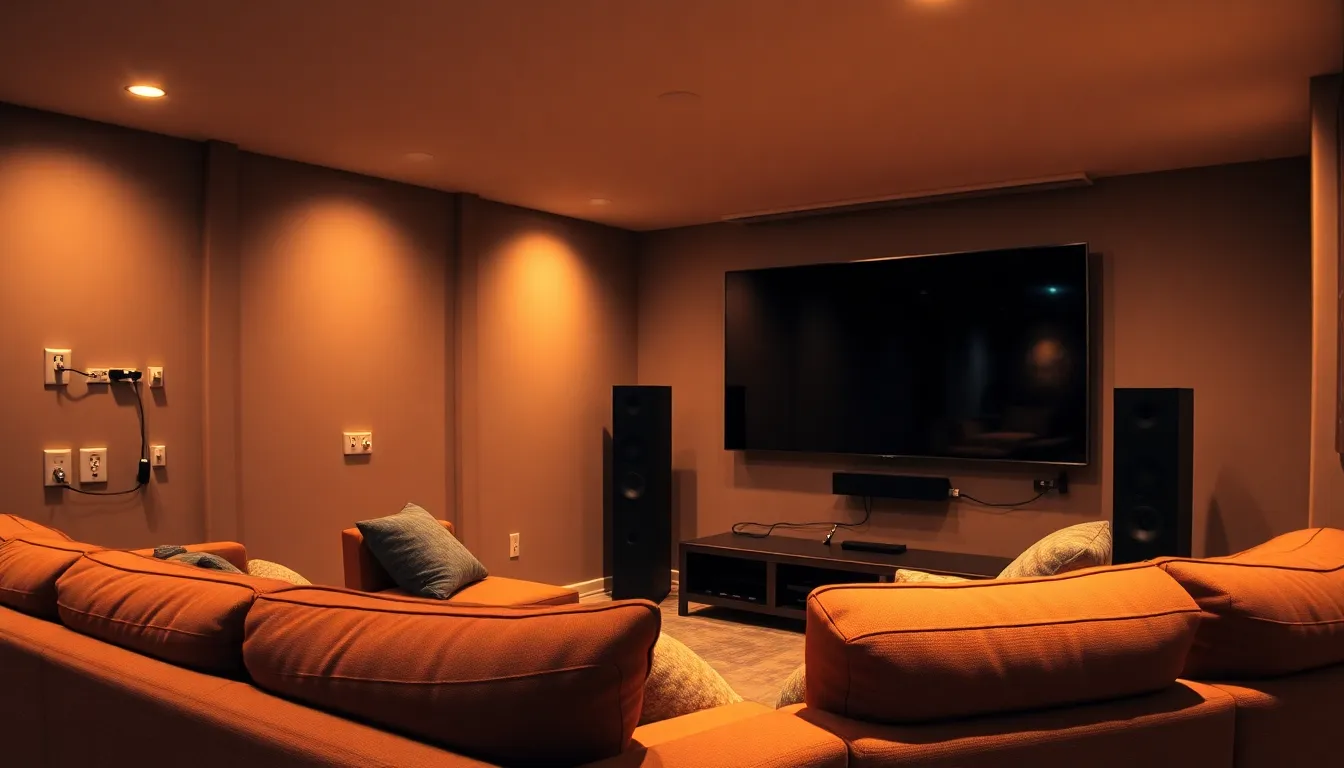
Proper electrical planning forms the foundation of any successful basement TV room conversion. We’ll need to ensure our electrical infrastructure can handle the demands of modern entertainment equipment while maintaining safety and code compliance.
Planning Adequate Electrical Outlets
Strategic outlet placement prevents overcrowding and creates a clean, functional entertainment space. We should install outlets no more than 12 feet apart along walls, with additional outlets required for any wall section over 2 feet wide. This spacing ensures we’ll have adequate power access for TVs, gaming consoles, sound systems, and other equipment without relying on extension cords.
Consider installing a mix of standard and GFCI outlets, especially near any potential moisture sources in the basement environment. We’ll want to place outlets at convenient heights, typically 18 inches off the floor, making them easily accessible behind entertainment centers and seating areas.
Separate circuits for lighting and major appliances prevent electrical overloads during peak usage. This approach ensures our movie nights won’t be interrupted by tripped breakers when multiple devices operate simultaneously.
Running Cables and Wiring Properly
Professional cable management creates a polished look while ensuring safety and code compliance. We should use appropriate wiring gauges based on our room’s electrical demands, with #12 wire for 20 amp circuits and #14 wire for 15 amp circuits.
Conduits protect and organize cables while meeting local electrical codes. These protective channels prevent damage from moisture or physical impact common in basement environments. Proper conduit installation also makes future upgrades or repairs much simpler.
Installing an adequate electrical panel or subpanel supports our room’s power needs effectively. We may need a new subpanel if our existing panel lacks sufficient slots or if running wiring from the main panel proves impractical for our basement location.
Installing Dimmer Switches and Smart Controls
Dimmer switches provide essential lighting control for creating the perfect viewing atmosphere. These switches allow us to adjust brightness levels for different activities, from bright lighting for gaming to dim ambient lighting for movie watching.
Smart home integration elevates our entertainment experience through remote control capabilities. We can control lighting, temperature, and even some audio equipment through smartphone apps or voice commands, improving both convenience and energy efficiency.
Installing smart switches and controls during the electrical phase saves money and effort compared to retrofitting later. These systems integrate seamlessly with popular home automation platforms, allowing us to create custom lighting scenes for different entertainment activities.
Budget-Friendly DIY Basement TV Room Ideas
Transforming your basement into an entertainment hub doesn’t require a massive budget when you embrace creative DIY answers. Smart repurposing and simple construction projects can deliver professional results at a fraction of the cost.
Repurposing Existing Furniture
Updating old sofas with fresh slipcovers or reupholstering them completely refreshes your seating while maintaining comfort for long viewing sessions. We recommend choosing dark fabrics that hide stains and complement the theater atmosphere you’re creating.
Transforming old pallets or crates into unique coffee tables provides both functionality and rustic charm without the hefty price tag of store-bought furniture. These upcycled pieces offer built-in storage compartments for remote controls, gaming accessories, and snacks.
Creating DIY seating options using bean bags or large floor pillows accommodates extra guests during movie nights or gaming sessions. These flexible seating answers easily move around the room and store compactly when not needed.
Creating DIY Lighting Answers
Installing string lights throughout the space creates a cozy ambiance that enhances the viewing experience without overwhelming the room with harsh illumination. We suggest warm white LED versions that consume less energy and produce minimal heat in your basement environment.
Repurposing old table lamps by updating their shades or adding new ones provides focused lighting for reading or casual activities between shows. Position these lamps strategically to avoid creating glare on your TV screen.
Using LED strip lights around your TV or along baseboards delivers a modern aesthetic while serving as bias lighting that reduces eye strain during extended viewing periods. These strips typically cost under $30 and significantly improve your room’s visual appeal.
Building Simple Storage Projects
Constructing shelving units using wooden crates or pallets creates dedicated storage for media collections, gaming equipment, and decorative pieces that reflect your family’s interests. These custom answers fit perfectly into awkward basement corners and alcoves.
Building bookshelves from reclaimed wood provides an economical way to store books, board games, and decorative items while adding warmth to your basement’s atmosphere. Reclaimed materials typically cost 50-70% less than new lumber while offering unique character.
Organizing with labeled storage bins keeps seasonal decorations, extra blankets, and rarely used items out of sight while maintaining easy access when needed. Clear bins work best for frequently accessed items, while opaque containers hide clutter effectively.
Conclusion
Transforming your basement into the perfect TV room doesn’t have to be overwhelming or expensive. We’ve shown you how to tackle everything from moisture control and electrical planning to creating cozy atmospheres with the right colors and lighting.
Whether you’re building a sophisticated home theater or a casual family hangout space your basement offers incredible potential. The key is balancing functionality with comfort while staying within your budget.
Remember that personal touches make all the difference. Your family photos sports memorabilia and DIY elements will turn this underground space into your home’s favorite gathering spot. Start with one area and build from there – soon you’ll have an entertainment haven that rivals any commercial theater.
Frequently Asked Questions
What makes a basement ideal for a TV room?
Basements offer natural sound insulation, flexible layouts, and separation from daily distractions. The underground location provides excellent acoustics for home theater experiences, while the typically rectangular shape allows for optimal furniture arrangement and viewing angles. Plus, you can control lighting more effectively than in rooms with large windows.
How far should seating be from the TV in a basement TV room?
Position your main seating 8 to 12 feet from the TV for optimal comfort and viewing experience. This distance reduces eye strain and provides the best picture quality. For larger screens (65+ inches), you may want to increase this distance slightly, while smaller TVs can accommodate closer seating arrangements.
What TV size is best for a basement entertainment room?
Choose your TV size based on viewing distance and room proportions. For typical basement dimensions, a 55-65 inch TV works well for most setups. Measure your viewing distance in inches and divide by 2.5 to get the recommended screen size. Always consider your room’s layout and ceiling height when making your selection.
How can I control moisture in my basement TV room?
Install proper ventilation systems, use dehumidifiers to maintain 30-50% humidity levels, and choose moisture-resistant materials like vinyl flooring and mold-resistant drywall. Ensure proper waterproofing before finishing, and regularly monitor humidity levels to protect your electronics and furniture from damage.
What lighting works best for basement TV rooms?
Install dimmer switches for flexible lighting control, add bias lighting behind your TV to reduce eye strain, and use blackout window treatments for theater-like experiences. Consider LED strip lights for ambient lighting and avoid placing lights directly in your line of sight to the screen.
What colors should I use for my basement TV room?
Dark colors like navy blue, deep gray, and charcoal work best as they reduce glare and improve screen visibility. These colors create an immersive theater atmosphere and make the screen appear brighter. Consider dark accent walls behind your TV and choose flooring in similar tones for the best viewing experience.
How do I plan the electrical requirements for a basement TV room?
Ensure adequate electrical outlets strategically placed around seating areas and entertainment centers. Plan for separate circuits for lighting and major appliances to prevent overloads. Use conduits for cable management, install dimmer switches, and consider smart home controls for enhanced convenience and energy efficiency.
What are some budget-friendly DIY ideas for basement TV rooms?
Repurpose existing furniture with slipcovers, create coffee tables from pallets or crates, and add bean bags or floor pillows for extra seating. Install string lights or LED strips for ambient lighting, build simple shelving from reclaimed materials, and use DIY acoustic panels made from fabric and foam for better sound quality.
How can I create good acoustics in my basement TV room?
Install in-wall speakers for optimal sound distribution, use soundproofing materials like acoustic panels or heavy curtains, and consider the room’s hard surfaces that may cause echo. Carpeting and upholstered furniture help absorb sound, while proper speaker placement ensures even audio coverage throughout the space.
What storage solutions work best for basement entertainment rooms?
Build or install shelving units for media storage, use entertainment centers with closed cabinets to hide clutter, and incorporate storage ottomans for dual-purpose furniture. Consider under-stair storage for larger items and use cable management systems to keep wires organized and out of sight.

